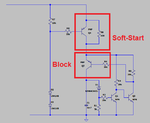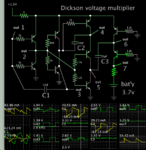miso156
Junior Member level 2
I am tying to charge a 4.7mF capacitor from a boost coverter, which is limited by very high resistance (100ohm) of its power supply. Anothe words, due to this the capacitor will be charged very slowly.

What happened is when the C1 voltage reaches Vmax after soft-start (charging via R3 initially), the capacitor voltage slowly falls to 1-2V, somethimes even converter stops oscilate, and then rise again to Vmax in 10s intervals.
I have a suspect, the energy from C1 flows back to converter and unload its output.
I would like to avoid to use another diode to isolate capacitor from whole circuit.

What happened is when the C1 voltage reaches Vmax after soft-start (charging via R3 initially), the capacitor voltage slowly falls to 1-2V, somethimes even converter stops oscilate, and then rise again to Vmax in 10s intervals.
I have a suspect, the energy from C1 flows back to converter and unload its output.
I would like to avoid to use another diode to isolate capacitor from whole circuit.





